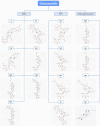Anti-cancer effect and potential microRNAs targets of ginsenosides against breast cancer
- PMID: 36278171
- PMCID: PMC9581320
- DOI: 10.3389/fphar.2022.1033017
Anti-cancer effect and potential microRNAs targets of ginsenosides against breast cancer
Abstract
Breast cancer (BC) is one of the most common malignant tumor, the incidence of which has increased worldwide in recent years. Ginsenosides are the main active components of Panax ginseng C. A. Mey., in vitro and in vivo studies have confirmed that ginsenosides have significant anti-cancer activity, including BC. It is reported that ginsenosides can induce BC cells apoptosis, inhibit BC cells proliferation, migration, invasion, as well as autophagy and angiogenesis, thereby suppress the procession of BC. In this review, the therapeutic effects and the molecular mechanisms of ginsenosides on BC will be summarized. And the combination strategy of ginsenosides with other drugs on BC will also be discussed. In addition, epigenetic changes, especially microRNAs (miRNAs) targeted by ginsenosides in the treatment of BC are clarified.
Keywords: MicroRNAs; breast cancer; combination therapy; ginsenosides; molecular mechanism.
Copyright © 2022 Fan, Shan, Lan, Fang, Song, Luo and Wu.
Conflict of interest statement
The authors declare that the research was conducted in the absence of any commercial or financial relationships that could be construed as a potential conflict of interest.
Figures


Similar articles
-
Recent Advances in Ginsenosides as Potential Therapeutics Against Breast Cancer.Curr Top Med Chem. 2019;19(25):2334-2347. doi: 10.2174/1568026619666191018100848. Curr Top Med Chem. 2019. PMID: 31648643 Review.
-
Novel Strategy in Breast Cancer Therapy: Revealing The Bright Side of Ginsenosides.Curr Mol Pharmacol. 2021;14(6):1093-1111. doi: 10.2174/1874467214666210120153348. Curr Mol Pharmacol. 2021. PMID: 33494691 Review.
-
Therapeutic effects of ginseng and ginsenosides on colorectal cancer.Food Funct. 2022 Jun 20;13(12):6450-6466. doi: 10.1039/d2fo00899h. Food Funct. 2022. PMID: 35661189 Review.
-
A Review of Neuroprotective Effects and Mechanisms of Ginsenosides From Panax Ginseng in Treating Ischemic Stroke.Front Pharmacol. 2022 Jul 7;13:946752. doi: 10.3389/fphar.2022.946752. eCollection 2022. Front Pharmacol. 2022. PMID: 35873557 Free PMC article. Review.
-
Anticancer Activities of Ginsenosides, the Main Active Components of Ginseng.Evid Based Complement Alternat Med. 2021 Feb 3;2021:8858006. doi: 10.1155/2021/8858006. eCollection 2021. Evid Based Complement Alternat Med. 2021. PMID: 33623532 Free PMC article. Review.
Cited by
-
Sustainable production of natural products using synthetic biology: Ginsenosides.J Ginseng Res. 2024 Mar;48(2):140-148. doi: 10.1016/j.jgr.2023.12.006. Epub 2024 Jan 3. J Ginseng Res. 2024. PMID: 38465212 Free PMC article. Review.
-
Mini-encyclopedia of mitochondria-relevant nutraceuticals protecting health in primary and secondary care-clinically relevant 3PM innovation.EPMA J. 2024 Apr 18;15(2):163-205. doi: 10.1007/s13167-024-00358-4. eCollection 2024 Jun. EPMA J. 2024. PMID: 38841620 Free PMC article.
-
Human disease-related long noncoding RNAs: Impact of ginsenosides.J Ginseng Res. 2024 Jul;48(4):347-353. doi: 10.1016/j.jgr.2024.04.002. Epub 2024 Apr 14. J Ginseng Res. 2024. PMID: 39036728 Free PMC article. Review.
-
Microorganisms for Ginsenosides Biosynthesis: Recent Progress, Challenges, and Perspectives.Molecules. 2023 Feb 2;28(3):1437. doi: 10.3390/molecules28031437. Molecules. 2023. PMID: 36771109 Free PMC article. Review.
References
Publication types
LinkOut - more resources
Full Text Sources

